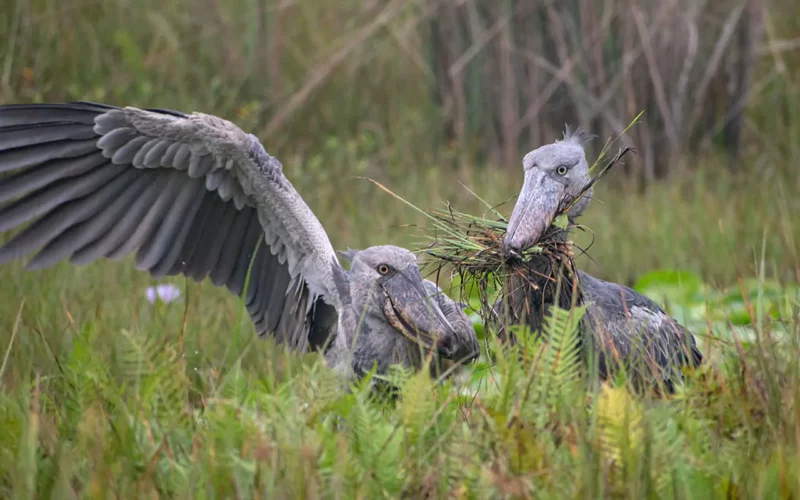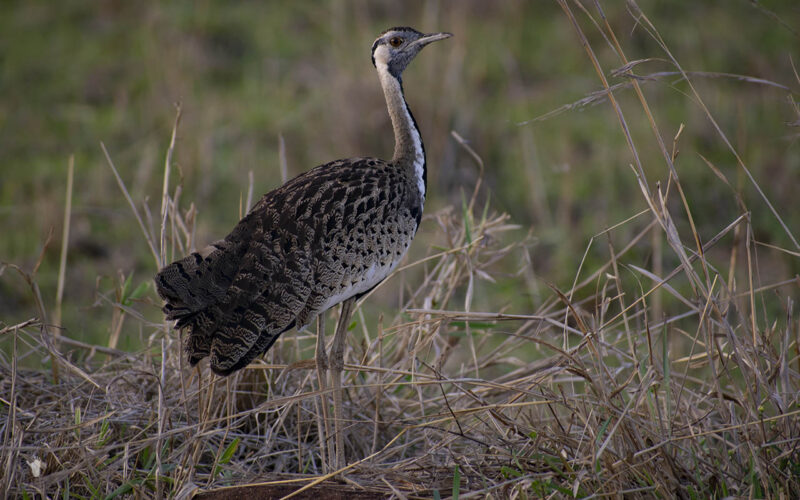Uganda, widely popular for it’s adventurous trekking experience along the mountain gorilla and chimpanzee, this small East African country is indeed a true birder’s paradise and a top tier for birding trip destination. Visiting casual birdwatcher and dedicated listers, will be impressed at the quality of bird diversity and how easy it is to bird here.
Uganda’s impressive 1080 species checklist across its plethora of diverse habitats, represents a 50% total of Africa’s bird checklist and an 11% of the world’s species checklist! Getting around birding hotspots is pretty easy given Uganda’s small size, compactness and a good road coverage. Modern infrastructure is everywhere and Uganda’s population is the friendliest on the continent. This connectivity affords quality birding experience as time is well spent exploiting diverse ecosystems that lie along any planned birding itinerary. Secondary, all birding sites are serviced by quality site guides and a wide range of accommodation plans.
A Quick Country Overview
- Size: 236000 km 2
- 1080 Bird Species (50% African Bird species)
- 2 Endemics; Fox Weaver (Ploceus spekeoides) and Karamoja Apalis (Apalis karamojae)
- Altitude 600-5010m
- Wet season: April-May and Oct-November
- Average Temperature 18-35 degrees C

Reasons to come birding in Uganda
-
Pleasant Equatorial Climate
Lying astride the equator crossing Uganda enjoys an all-year round equatorial weather with local wet/dry annual seasons. Generally climate is highly influenced by the country’s high average elevations of about 1000m asl, and numerous topographic features including mountain ranges, vast rainforests and open water. Even then its an all-year round birding destination.
-
Diversity of Bird Habitats and Species Highlights
Uganda sits at the convergence of Africa’s biggest biomes/habitats and transitional zones. Here the vast East African savannas meets the expansive West Africa tropical rainforests. The center of this biodiversity is the bird-rich Albertine Rift that run through the heart of the continent, covering the entire western border line of Uganda to extend through Rwanda and beyond. This Africa’s most ecological ecosystem protect a wide range of endemic flora an fauna. This diversity include the world’s only population of mountain gorilla, chimpanzee, the golden monkey and a 37 specie list of birds. Uganda offers the best access to explore this rich biodiversity where birders get tick off up to 27 of the total 37 Albertine Rift restricted endemics.
For most visiting birders to Uganda, the vast wetlands that flank most open water and rivers are a great place to explore for various wetland and water associated species. The much sought-after specialist of this L. Victoria biome is the bizarre looking mythical and prehistoric Shoebill. Rare elsewhere across its range on the continent, the marshes along the northern edges of L. Victoria and the river Nile flood plains offer the best chances to encounter this dinosaur era species.
Birding the lowland forests of Semuliki, Budongo and Kibale Forest brings in quality Guinea-Congo biome species to a Uganda checklist as they occur here at the edge of their range limit. The vast savanna and woodlands that cover most of the northern region of Uganda host Sahelian species on their southern range limit unique to the Sudan and Guinea biome. The north-east of Uganda host the Somali-Masai Biome specialists across the dry bush and rocky habitats that cover this region with notably great species.
What to consider when Planning a Birding trip to Uganda
After building enough reasons as why you need to come birding in Uganda, let’s now dive into the planning guide, shall we?
- Birds, Gorillas, Chimpanzee and more…
Uganda is an accomplished travel destination with various bucket-list and once-in-a-lifetime activities. These include gorilla and chimpanzee tracking experiences, rafting, hiking, community tours and wildlife safaris. To most visiting birders, they find it easy and convenient to take on these activities given that it’s these same habitats that we are birding in. Therefore, any tailored birding itinerary usually allow time for these extra activities that also attract independent fees for permits.
- Experience with East African Birds
When planning a birding trip to Uganda, it becomes easy to tailor a suitable package considering your past experience birding any other East African destinations. On developing a package then, one will consider ample time to exploit a particular site collecting specialists that occur there. Uganda offers a safe access to the Albertine Rift top birding sites of Bwindi Impenetrable Forest, Mgahinga NP, Echuya Forest to tick off the local endemics. And with a short distance between sites and excellent road infrastructure, it makes birding these sites much easy.
- Generate a Wish-list
Call it a shopping list if you may! A wish list is a sure way to keep you motivated on a tour seeking new lifers and local sightings. This helps your private guide in planning which birding sites to explore. Thanks to technology, its easy to look up a destination and see what species occur there. One go-to resource is the E-bird site, although with errors it gives one a picture of what to expect. Another great and detailed guidebook is the Birds of East Africa by John Fanshawe and T. Stevenson available as a hardcover or e-copy. Birds of Africa by Sinclair is bulky but offers a detailed information on all the continents checklist.
- Consider which sites to Bird in and Tour Duration
With a target list, you are able to tell which site to visit and how long you will stay there. Duration oncourse largely depends on one time and other bucket-list experiences. Popular packaged birding tours in Uganda exploring most birding sites will run an average 28-30-Days Birding Trip. Shorter options like our 11-Day Albertine Endemic Birding Trip targets the Albertine Rift for its 24 Albertine Endemics.
- Consider the local Climate Seasons
Uganda’s tropical climate makes it an all-year birding destination however, there are regional variations influenced by local topography and altitude. Central Uganda and western highlands have two wet seasons April-May and Oct-Nov while the north and north east of the country have a single but long wet season from April to October. And from our own experience, the early weeks of the rain season seems more productive as there is abundant of food, and most species (insectivores) target this wet season.
- Consider local Bird migration Season
While planning a birding trip to Uganda, one would take into consideration local bird migration. As Uganda lies on a migration corridor, the months of Oct to May millions of Palearctic migrants from the northern tropics occur in many of our savanna parks, estuaries and explosion crater lakes. Several are passage migrants on their way further south while some choose to winter around. This cast of characters include small to large waders, various warblers, wagtails, large eagles and storks. The migration is an exciting birding time as many species occur in large congregations and dressed in non-breeding plumages. Another cast of characters include several Intra-African species especially from southern hemisphere coming to the equator from September to escape the cold winter returning early Feb and March. Most are encountered in forests and several woodlands.

Choose your Style and Comfort on your Birding Trip in Uganda
With the above guidelines settled, let us now get personal here; what is your style and comfort.
- Your Private Bird Guide
Uganda’s local bird guides are very knowledgeable and even fluent in several international languages. Whether you plan to travel independently or book with a local company a knowledgeable bird guide is very crucial to your birding experience. Utilize their vast knowledge about their country, latest local sightings, local site knowledge and local connections to enhance your birding experience. Besides, they come from the immediate communities and that income not only improves livelihood of communities but it assures protection of these ecosystems. This is sustainability!
- Mode of Transport and Accommodation Options
With most of Uganda connected with excellent road network, trail heads to birding sites sites lie on dirt roads that require strong and study vehicles. Take note that these short dirt roads tend deteriorate in the rain season. A 4X4 Landcruiser is a great option that provide excellent leg-room, has great clearance, and provides window access for easy birding. An open roof enhances quality birding while in several savanna parks.
A variety of accommodations suiting one’s comfort and budget lie within and around top birding sites, all our recommendations are bird friendly properties and close to birding trail heads.
- Consider the Price and Don’t break the bank…!!
Now the last one is, what is the right price? This is determined by your style and comfort, tour duration, quality of bird guide, accommodations and mode of transport. Take note of cheap packages, they look to good to be true. But then, there are exaggerated packages too!
The right price should be determined by your personal level of comfort and duration.
Parking List for a Birding trip to Uganda
Lastly, getting ready to set off to Uganda, a full parking list would include your usual birding gear and camera along with;
- A hat and sun scream for that scorching sun
- Sunglasses
- A warm jacket or sweater for those evenings while in high altitude areas!
- Good walking shoes for forest birding
- Easy walking shoes as you bird in the car in the hot savanna grasslands
- Rain gear
- Personal medication as advised by your GP on travels to the equatorial Africa
- Lastly a warm attitude…as each day is different!
